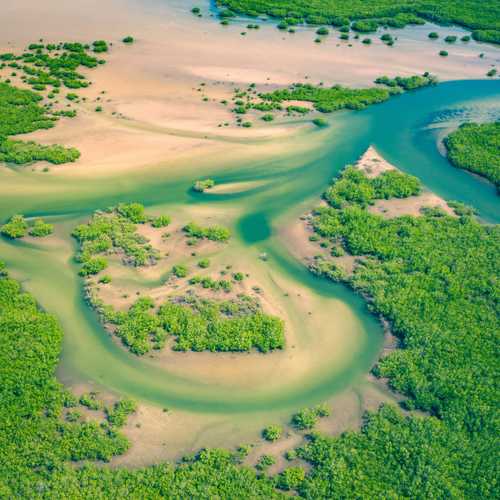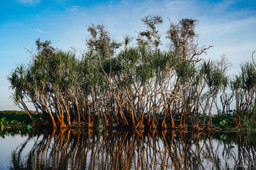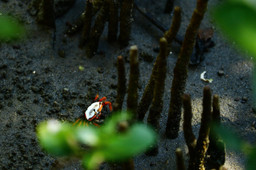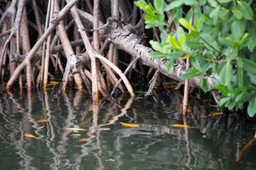
What are mangrove forests, why are they under threat, and what can be done to save them?
In terms of types of biodiverse habitats, rainforests and coral reefs are seen as the glamorous options. Swampy wetland is not generally viewed as being so appealing – yet this article asks you to reconsider. In it, earth.fm will introduce you to mangrove forests: what they are, and the reasons they are so important as habitats and as carbon sinks, why they are under threat, and what can be done to protect them.
What is a mangrove forest?
Mangroves are hardy trees or shrubs which have become adapted for survival in intertidal zones (the land between the highest and lowest tide marks), where other plants would die. They can survive in saline water by limiting their salt intake, and have evolved buoyant seeds which can be dispersed by water.
These plants are typically characterized by the presence of tangled, stilt-like prop roots. By disrupting and slowing the tidal movements of seawater, these roots allow sediment to build up – meaning that coastlines which support mangrove forests are stabilized against erosion.
Where are mangrove forests found?
Because mangroves are unable to survive freezing temperatures, forests of this type (alternatively known as mangrove swamps) form wetland biomes primarily only in tropical and subtropical latitudes. Salt marshes instead predominate in temperate areas.

Where is the world’s largest mangrove forest?
The largest share of global mangrove forests – 38.7% – is located in Asia, where the world’s largest mangrove forest, the Sundarban, in the Bay of Bengal delta, spans 3,900 square miles (10,000 km²) of India and Bangladesh.
The Sundarban is considered endangered according to the International Union for Conservation of Nature (IUCN)’s Red List of Ecosystems. Meanwhile, the greatest diversity of mangrove forests types – delta, estuary, lagoon and open coast – is found in Southeast Asia.
What animals live in the mangrove forests?
Mangrove forests provide an important habitat to thousands of species.
The tidal fluctuations experienced by mangrove forests mean that opportunistic foraging flexibility is important for birds in these regions. Therefore, mangrove forests support many generalized foragers, but relatively few bird species are specific to mangroves, by comparison to other forest types.
Because they provide food and shelter, the root systems of mangrove forests provide crucial breeding grounds for a large proportion of the planet’s fish, crabs, and shellfish. A large proportion of fish which are caught commercially either subsist in mangroves at some point, or rely upon mangrove-related food webs.
The juveniles of many fish species start their lives in mangrove forests, before transitioning to finding food in seagrass beds and finally entering the ocean proper when they reach adulthood.

Other species which call mangrove forests home range from fishing cats and Bengal tigers to proboscis and crab-eating macaque monkeys, giant monitor lizards, olive ridley sea turtles, white-bellied sea eagles, manatees and dugongs – and even various tree-climbing fish.
Why are mangrove forests important?
In addition to providing habitats for a diverse range of interdependent species, in combination with seagrass beds and coral reefs, mangrove forests also maintain the health of coastal zones. Mangroves, seagrass beds, and coral reefs are often found together and work in concert:
- By trapping sediment and pollutants, the trees prevent them from entering the sea
- Seagrasses stop silt and mud from smothering reefs
- The reefs provide protection against strong ocean waves for the seagrasses and mangroves
Mangrove forests are also significant ‘blue carbon’ sinks in tropical coastal ecosystems – storing three to four times more carbon than other types of tropical forest – and can even form peat deposits through the action of fungi, bacteria, and termites.
In addition, “even modest mangrove forest coverage has the capacity to provide tremendous storm protection services” to coastal communities – even in the face of tsunami and cyclones.
Why are mangrove forests being destroyed?
In 2001, it was reported that 35% of mangrove forests, if not more, had been lost in the previous 20 years – more than the losses suffered by the more famously under-threat tropical rainforests and coral reefs. Human activity responsible for this destruction includes:
- Urbanization,
- The conversion of mangroves to agriculture and mariculture (the cultivation of marine organisms),
- The harvesting of wood for the production of charcoal (which can be ameliorated by the distribution of solar cookers),
- The consequences of warfare.
The farming of shrimp has a particularly deleterious effect on mangrove forests; it is estimated to be responsible for the destruction of a quarter of these habitats.

The closed ponds system (as opposed to the integrated mangrove-shrimp aquacultural system) is particularly detrimental, as it necessitates the forests being wiped out on a large scale, while the antibiotics and disinfectants used to manage the spread of disease in this closed system may also affect the adjacent habitat.
How can we protect mangrove forests?
Various methods are in use to incentivise the conservation of mangrove forests worldwide, often on a grassroots, community-level basis. For example:
- The production of ‘mangrove honey’ in Thailand and Madagascar provides a sustainable source of income for local people.
- Similarly, also in Madagascar, collection of the silk pods of silkworm species endemic to mangrove forests in the country can also provide revenue.
Mangrove reforestation and afforestation is also being carried out around the world. In Java, Indonesia, for example, where mangrove forests have suffered 70% losses, Dutch techniques for retaining sediment are being used to give mangrove seeds bases upon which to grow. Elsewhere, seeds are even being deposited by drones.
However, the sensitivity of mangrove forest ecosystems means that restoring them can be challenging. Nevertheless, through engagement with local stakeholders, initiatives such as the IUCN and the United Nations Development Programme’s Mangroves for the Future project is encouraging the rehabilitation of these vital habitats, in order to conserve their benefits to both wildlife and human communities, and their carbon sequestration properties.
Earth.fm soundscapes you may enjoy:
Featured photo by Curioso Photography on Unsplash
Earth.fm is a completely free streaming service of 1000+ nature sounds from around the world, offering natural soundscapes and guided meditations for people who wish to listen to nature, relax, and become more connected. Launched in 2022, Earth.fm is a non-profit and a 1% for the Planet Environmental Partner.
Check out our recordings of nature ambience from sound recordists and artists spanning the globe, our thematic playlists of immersive soundscapes and our Wind Is the Original Radio podcast.
You can join the Earth.fm family by signing up for our newsletter of weekly inspiration for your precious ears, or become a member to enjoy the extra Earth.fm features and goodies and support us on our mission.
Subscription fees contribute to growing our library of authentic nature sounds, research into topics like noise pollution and the connection between nature and mental wellbeing, as well as funding grants that support emerging nature sound recordists from underprivileged communities.

